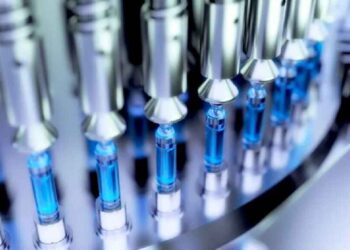A new method for creating stem cells for the human liver and pancreas, which could enable both cell types to be grown in sufficient quantities for clinical use, has been developed by scientists.
Using the technique, researchers have for the first time been able to grow a pure, self-renewing population of stem cells specific to the human foregut, the upper section of the human digestive system.
These so-called “Foregut stem cells” could then be developed further to produce liver or pancreatic cells. The method significantly improves on existing techniques for cultivating this type of stem cell, and raises the possibility that, with further work, they could be grown in large numbers in bioreactors. That would make it possible to use them for regenerative therapies, repairing damaged organs or tissues in the body, and treating conditions such as type I diabetes or liver disease.
“We have developed a cell culture system which allows us to specifically isolate foregut stem cells in the lab,” Dr Nicholas Hannan, from the University of Cambridge Wellcome Trust MRC Stem Cell Institute, Department of Surgery, explained. Hannan led the study, which was carried out in the lab of Dr Ludovic Vallier.
“These cells have huge implications for regenerative medicine, because they are the precursors to the thyroid upper airways, lungs, liver, pancreas, stomach and biliary systems. We now have a system where we may be able to create all these cell types from the same starting population.”
As reported in the journal Stem Cell Reports, the method also means that researchers will be able to analyse the embryonic development of foregut cells in greater depth. “We now have a platform from which we can study the early patterning events that occur during human development to produce the intestines, liver, lungs and pancreas,” Hannan added.
The approach marks a breakthrough because it overcomes some of the problems which currently limit scientists’ abilities to grow cells associated with the liver, pancreas, and other parts of the foregut in sufficiently large numbers for clinical use.
Stem cell growth starts with human pluripotent stem cells (hPSCs). These are non-specialised biological cells with the potential to transform – or “differentiate” – into any of the three primary layers of cells from which all tissues and organs develop. Because these cells also self-renew, creating copies of themselves, they offer the potential to provide an infinite source of clinically usable cells for regenerative medicine.
Achieving this, however, relies on scientists developing effective methods through which they can influence the differentiation of hPSCs. To grow pancreatic or liver cells, hPSCs are differentiated into the endoderm – the primary tissue layer associated with the digestive and respiratory systems. This provides a base population of progenitors which researchers can then try to develop as more specialised cells.
Unfortunately, the approach is far from perfect. In particular, it is difficult to produce a pure population of the required progenitors, and “contaminating” cells of the wrong type are typically found within the cell culture. This makes it difficult to identify the target cells for further differentiation in the lab and can complicate the application of these cells in transplant therapies. In some cases, hPSCs also produce such a large number of contaminating cells that the precursor population becomes unusable.
To address these limitations, the research team carried out a detailed study of the conditions in which stem cells differentiate specifically into the human foregut – the section of the digestive system extending from the mouth to the duodenum, and including the liver and pancreas.
By manipulating the signal pathways of the cells, and varying the environment in which the cells were developed and the substrate on which they were grown, they were able to isolate the precise culture needed for the differentiation of cells associated with the foregut itself. When heavily contaminated stem cell populations were developed under these conditions, the contaminating, non-endodermal cells eventually stopped proliferating and gradually disappeared. The universal nature of this culture system takes a step towards a universal system that could be used to treat any patient requiring cells for transplantation purposes.
The result was a much purer, self-renewing population of human foregut stem cells (hFSCs). The cells generated are true stem cells because they are able to self renew and can differentiate towards any part of the foregut. Because they are also still at the stage where they self-renew, they could be grown in large enough numbers to be used in clinical therapies.
The team was also able to show that these human foregut stem cells do not form tumours, which means that they can be safely injected for therapeutic purposes, without having adverse side effects.
Although the procedure does not improve scientists’ ability to produce pancreatic or liver cells specifically, it does provide a much purer source population for doing so. “What we have now is a better starting point – a sustainable platform for producing liver and pancreatic cells,” Dr Ludovic Vallier said, senior author of the study. “It will improve the quality of the cells that we produce and it will allow us to produce the large number of uncontaminated cells we need for the clinical application of stem cell therapy.”
The team is now building on the research by studying the fundamental mechanisms which control the differentiation of hFSCs specifically as liver cells or pancreatic cells, to further improve the production of these cell types for regenerative medicine.

















